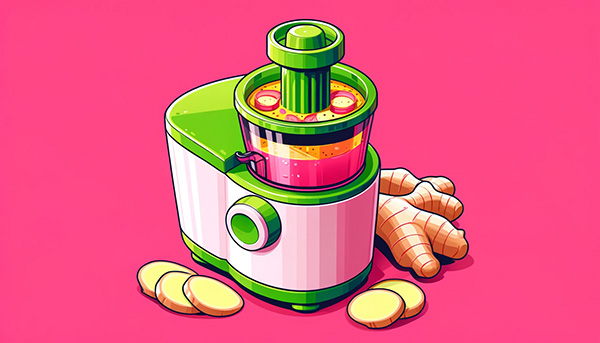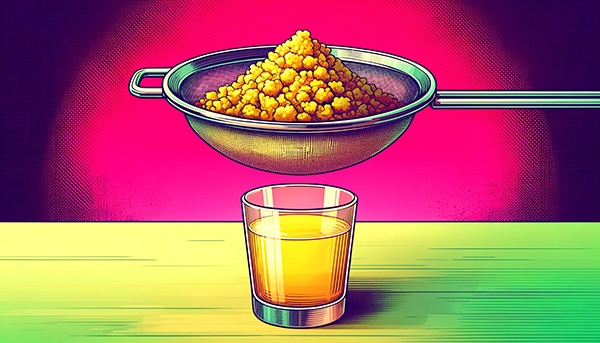Ginger is a humble root treasured for centuries in various cultures for its unique flavor profile and remarkable medicinal properties. While ginger can be found in many dishes, from curries to cookies, one of the most refreshing and invigorating ways to harness its power is by creating your own ginger juice!
In this post, we will discuss how to make ginger juice with and without a juicer.
What You Will Need To Make Homemade Ginger Juice
Fresh Ginger Root
Of course, fresh ginger root is the star ingredient of ginger juice. You can't make ginger juice without it! To make ginger juice that is excellent in flavor and nutrition, start with high-quality ginger root. Look for firm, plump, fresh ginger free from signs of decay, such as wrinkling or mold. Freshness ensures you'll get the most flavor and nutritional benefits from ginger juice.
Examine the ginger's skin. It should be smooth and unblemished. While ginger skin is edible, it can be tough and fibrous! Peeling is often recommended for smoother juice. Wrinkles or damage to the skin can serve as an indicator that the ginger has exceeded its optimal freshness.
Give the ginger root a gentle sniff. Fresh ginger has a potent, spicy, slightly sweet aroma that can instantly awaken your senses. The stronger the aroma, the more flavorful your juice will be. If the ginger lacks fragrance, it may have lost some of its pungency.
The amount of ginger you need depends on your preference and the quantity of fresh ginger juice you want to make. A small piece, approximately 2 to 3 inches in length, is typically sufficient for a moderate amount. Nevertheless, you can modify the quantity to match your preferences, including more for a bolder ginger taste.
I recommend using organic ginger grown without synthetic pesticides or herbicides to make homemade ginger juice. This means you are less likely to be exposed to potentially harmful chemicals when consumed. Conventional ginger may carry pesticide residues, which can concern health-conscious consumers.
Knife Or Peeler
A sharp knife is a key for efficiently peeling ginger root. The thin, tough skin of ginger can be easily removed with a sharp blade, making the peeling process quicker and more precise. If you're uncomfortable using a knife (or want to simplify the peeling process), consider using a potato peeler. These specialized kitchen tools are designed to remove ginger skin efficiently.
After peeling, cut the ginger into smaller, uniform pieces suitable for processing in a blender or juicer. This uniformity ensures consistent juicing results and helps avoid large, fibrous chunks hindering the juicing process.
Juicer Or Blender
When making ginger juice, you have two main options - a juicer or a blender.
Juicers are specialized appliances crafted exclusively to extract juice from fruits and vegetables. They separate the fresh juices from the ginger pulp, resulting in a clear liquid ready to drink. There are two types of juicers: centrifugal and masticating juicers.
Centrifugal juicers work by rapidly spinning a mesh basket to separate the juice from the leftover pulp. While they are efficient for certain fruits and vegetables, they may not be the best choice for juicing ginger, as ginger is particularly fibrous and can clog the machine.
On the contrary, masticating juicers function at a lower operating speed. They use a chewing or crushing mechanism to extract homemade juice. They are generally more effective at juicing ginger as they can handle fibrous ingredients better and yield a higher juice quantity. If you plan on combining ginger juice with other fresh juice from other fruits (such as apples), I recommend using a masticating juicer.
Blenders are more common for home use and work well for juicing ginger. High-speed blenders are optimal because they can extract the maximum amount of juice. Blenders retain the fiber content of ginger, resulting in a juice that includes ginger pulp. This can be advantageous since ginger's fiber is linked to numerous health benefits, particularly concerning digestive health. However, thicker ginger juice with much of the remaining pulp may not be to your liking.
Strainer, Cheesecloth, Or Nut Milk Bag (Optional)
Using a strainer, cheesecloth, or a nut milk bag is an optional (but valuable!) step when making ginger juice. However, I recommend using one for the blender method. These tools help create a smoother, more refined ginger juice by separating ginger fibers and other solids, enhancing the final beverage's taste and texture. While using a juicer doesn't result in a lot of ginger pulp, using a blender does!
Bowl Or Pitcher
A bowl or pitcher collects freshly extracted juice. As the juicer or blender processes the ginger, the juice flows into this container, ensuring it doesn't spill or make a mess on your kitchen counter!
Choose a container with an adequate capacity to hold the amount of ginger juice you intend to make. Consider the size of your ginger root and how much juice you plan to extract. Having a container that comfortably accommodates the juice prevents overflow and allows for easy pouring.
Speaking of containers - I recommend using a glass container instead of plastic to store your ginger juice! Glass is free from toxins and does not release harmful chemicals into your ginger juice, guaranteeing that your drink remains untainted. It also does not retain or transfer odors or tastes from previous uses, allowing the natural flavors of your ginger juice to shine without any interference. In contrast, some plastics can release potentially harmful substances when exposed to acidic or hot liquids.
Optional Ingredients
While ginger juice can be enjoyed independently, you can enhance its flavor and nutrition by adding other optional ingredients! These include fresh lemon juice, honey, fresh mint, fresh turmeric, cayenne pepper, or a pinch of black salt. These additions can provide a pleasant tanginess and sweetness to your ginger juice.
How To Juice Ginger In A Juicer To Zing Up Your Life
1. Peel Ginger Root

Use a knife or spoon edge to peel the ginger root. The ginger root skin can be tough and fibrous, so removing it ensures a smoother juice. However, the ginger pump contains many nutrients, so feel free to make ginger juice with the peel left intact. You may prefer it!
2. Cut Peeled Ginger Into Small Pieces

Once peeled, slice the ginger root into small pieces that conveniently fit into the juicer's feeding chute. This step facilitates the juicing process and helps prevent clogs in the machine.
3. Turn On Juicer

Plug in and turn on your juicer, following the manufacturer's instructions for your specific model.
4. Feed Ginger Pieces Into Juicer

Start feeding the small ginger root pieces into the juicer's feed chute one at a time. Wait until each piece has been fully processed before adding the next one. As you feed the ginger root into the machine, the juicer will extract the liquid from the ginger, and the ginger juice will flow into the collection container.
5. Enjoy!

Transfer your ginger juice into a glass or container when it is prepared. Enjoy your freshly made ginger juice immediately to savor its vibrant flavor and the nutritive benefits of ginger root! Alternatively, you can store unused ginger juice in the refrigerator for a few days.
How To Make Ginger Juice Using A High Speed Blender
1. Cut Ginger Into Small Pieces

Peel and wash ginger roots, then cut into smaller pieces. This will simplify the blender's task and enhance its juice extraction efficiency.
2. Blend Ginger

Place the ginger pieces into the blender. For a smoother juice, you can incorporate a modest quantity of water, typically around 1/4 to 1/2 cup, to facilitate the blending process. Use coconut water if you'd like! Blend the ginger until it becomes a smooth, pulpy consistency. Depending on your blender's power, this may take a minute or two.
3. Strain Ginger Juice

If you'd prefer juice with a thinner consistency, you'll need to stain out the pulp. Place a cheesecloth or a milk bag over a bowl or pitcher to stain out the grated ginger pulp from the juice. Pour the blended ginger mixture through a cheesecloth or milk bag to strain out any leftover pulp. You can gently squeeze the cloth or bag to extract more juice.
4. Enjoy!

Pour your fresh ginger juice into a glass, and enjoy! Drinking ginger juice immediately allows you to enjoy it at its peak of flavor and nutrition! After drinking as much ginger juice as you'd like, store any unused juice in the refrigerator for a few days.
Ways To Elevate Homemade Ginger Juice
Add Fresh Herbs
Fresh herbs like mint, basil, or cilantro can take your juice to a new level. Gently crush the herbs to release their essential oils and mix them with the freshly juiced ginger. The herbal aroma and taste will infuse the juice, offering a refreshing and aromatic twist.
Ginger Tea
Turn your ginger juice into a soothing ginger tea by steeping it in hot water. The hot water transforms the juice into a warm, comforting beverage - ideal for sipping on a chilly evening! Add honey, maple syrup, or agave syrup for a sweeter ginger tea or a slice of citrus for a more complex flavor.
Ginger And Fruit Smoothies
Boost your fruit smoothies with ginger juice! Ginger's innate spiciness complements sweet fruits such as pineapple, mango, or banana, enhancing both the flavor and potential health advantages of your smoothie.
Ginger Mocktails
Fresh ginger juice is a great addition to any mocktail or as a ginger beer substitute in mocktails.
Ginger And Turmeric
Take your ginger juice as a "ginger shot" for a quick and refreshing health boost. It's especially popular in the morning to kickstart your day.
Ginger Shots
Take your ginger juice as a "ginger shot" for a quick and refreshing health boost. It's especially popular in the morning to kickstart your day.
How To Store Fresh Ginger Juice
The most common method for storing fresh ginger juice is refrigeration. Transfer the juice to a clean, airtight glass container or bottle with a secure lid. Ensure that the container is tightly sealed to prevent air from entering. Keep the ginger juice in the refrigerator at a temperature of 35-40°F (1-4°C). The colder setting helps to decelerate the oxidation process, maintaining the juice's freshness.
To prolong the shelf life of your ginger juice, you can opt to freeze it. Fold and freeze the ginger juice into an ice cube tray or silicone mold. Once frozen, remove the cubes from the ice cube trays and place them in an airtight, freezer-safe bag or container. Frozen ginger juice can be stored for several months and utilized as required.
Frequently Asked Questions
Can I Drink Ginger Juice Everyday?
Indeed, incorporating ginger juice into your daily routine is a viable option! It offers numerous potential health advantages. However, if you are drinking too much ginger juice, it can cause nausea and gastric reflux for some.
What Are Ginger Juice Benefits?
Ginger juice offers many potential nutritive benefits due to bioactive compounds like gingerol. Here are some of the key benefits associated with consuming ginger juice:
Digestive Aid: Ginger juice can help relieve indigestion, bloating, and gas. It promotes the secretion of digestive enzymes and may improve overall gut health.
Nausea Relief: Ginger juice is a renowned natural remedy for alleviating nausea and vomiting, proving especially effective for conditions like motion sickness, morning sickness during pregnancy, and post-operative nausea.
Anti-Inflammatory Properties: Gingerol, a bioactive compound in ginger, has potent anti-inflammatory effects. Regular consumption of ginger juice may reduce inflammation, a factor associated with various chronic diseases.
Pain Management: Ginger juice may alleviate various types of pain, including headaches, migraines, muscle soreness, and joint pain. This makes it a natural alternative to over-the-counter pain relievers.
Immune System Support: Ginger is abundant in antioxidants, which can aid in fortifying the immune system. Regular consumption of ginger juice may contribute to improved immune function and better protection against infections.
Cardiovascular Health: Several studies indicate that ginger may have the potential to lower blood pressure and reduce cholesterol levels, potentially benefiting heart health.
Weight Management: Ginger juice may boost metabolism and reduce appetite, potentially aiding in weight management efforts when consumed as part of a balanced diet and exercise plan.
Improved Blood Sugar Control: Initial research suggests that ginger may assist in regulating blood sugar levels, offering potential benefits to individuals with diabetes or those at risk of developing the condition.
Gut Health: Ginger has the potential to foster a healthy gut microbiome by encouraging the proliferation of beneficial gut bacteria. A well-balanced gut microbiome is linked to overall well-being.
Anti-Aging Properties: Ginger's antioxidants can shield skin cells from oxidative stress and the effects of aging, potentially promoting healthier and more youthful-looking skin.
Respiratory Health: Ginger has natural antibacterial and anti-inflammatory properties that may help soothe respiratory conditions like coughs and sore throats.
Improved Cognitive Function: Certain studies propose ginger's antioxidants could benefit cognitive function and memory, potentially lowering the risk of age-related cognitive decline.
